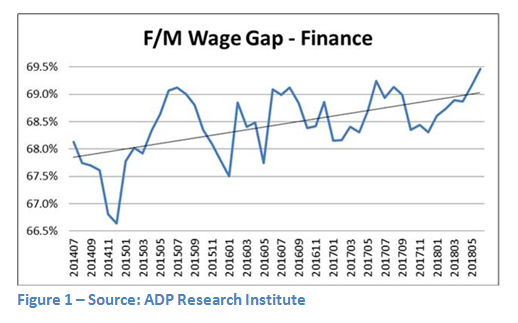
©lolostock/iStock/Getty Images Plus
Research shows that a gender pay gap exists in all industries. However, looking more closely at the data, it is interesting to discover how much larger the gap is in certain sectors. For example, while the finance industry has made strides in hiring more women and working to address equal pay for women and men in the same positions, the industry has one of the widest gender pay gaps. The ADP Research Institute® (ADPRI) conducted a study following newly hired exempt employees for next six years of career and subsequent report titled Rethinking Gender Pay Inequity in a More Transparent World to better understand how recruiting, base pay and incentive pay might contribute to gender disparity across the U.S. workforce. After tracking salary and bonus pay of approximately 11,000 employees across six major industries from 2010 through 2016, it was confirmed that a significant gap remains in what both genders earn, on average. Women, on average, earn a 17 percent ($15,000) lower salary than men. However, when factoring in the gender pay gap for bonus pay (69 percent), the total earnings pay gap widens to 19 percent ($18,500).
The pay gap fluctuates across industries. Women in the finance and real estate sector earn 21 percent less in their bonus-to-base ratio compared to men. More astonishing, this industry has the largest pay gap for women with and without incentive pay.
What Drives Pay Disparity?
The causes of pay disparity between men and women are tremendously complex and diverse. That’s because there are many tangible and intangible factors driving pay inequity. Some of these factors include recruitment, job role definition, performance review, age and tenure, incentive pay, education level, promotion opportunities, industry, career path, etc. It is also known that women approach their careers differently than men, which is backed up by ADP RI’s extensive research on HR and wage growth.
Many of these factors contribute to the overall 27 percent pay disparity between male and female workers in the U.S. While it is difficult to determine which issues employers should address, one place to start is by isolating two causes—incentive pay and total compensation - to better understand why women, on average, are paid substantially less than men.
Finance Industry Pay Under a Microscope
There is a 76 percent gap in average annual total earnings with women making 24 percent less than men in the finance industry. Looking closely at average hiring salary, the wage gap is 78 percent and women get paid 22 cents per dollar less than male counterparts. More surprising, female employees also earn 21 percent less than men in their bonus to base ratio which exacerbates the total earnings gap to 76 percent. .
Although the finance industry pay gap is closing, the diagram below shows that this is happening slowly—by almost 2 percent—over the last four years.

For an industry comprised of 55 percent women, the pay disparity is in stark contrast to other industries which could be due to this sector’s wide-ranging job levels and differing skill sets. Women often work in lower wage retail bank teller positions or part-time as an insurance agent which can often accommodate work-life balance needs. In contrast, men often hold investment or mergers and acquisitions banker positions. In this instance the compensation difference could be dependent upon the proportion of women and what kind of jobs they’re in. It’s the concentration of women at these lower paying jobs—positions that generally do not include incentive pay—that might be perpetuating the pay gap.
Investing in Closing the Gender Pay Gap
How should finance leaders become advocates for pay equality and play a key role in supporting organizational efforts to identify and close the gender pay gap? Executives can start the process by working with HR managers and others in senior leadership roles to implement these five actions:
- Conduct a comprehensive pay equity review that encompasses base pay, incentive pay and total compensation
- Review recruiting practices and guidelines provided to hiring managers to negotiate salary and incentives for new hires
- Examine promotion decisions for evidence of “pay bias” (i.e., awarding promotions based upon salary history rather than performance and fit with position)
- Create an HR technology ecosystem that supports monitoring and analysis of all aspects of compensation on an ongoing basis
- Improve communications practices to help ensure that employees and supervisors have a clear understanding of fair pay practices
While the data shows that progress to close the pay gap is slow, there are signs of greater efforts to offer equitable pay and opportunities to promote women to higher paying leadership positions. Although the road ahead is long, a great first step is analyzing pay data to determine where an organization stands and make a data-informed decision on how best to proceed.
Ahu Yildirmaz is Co-head, ADP Research Institute.